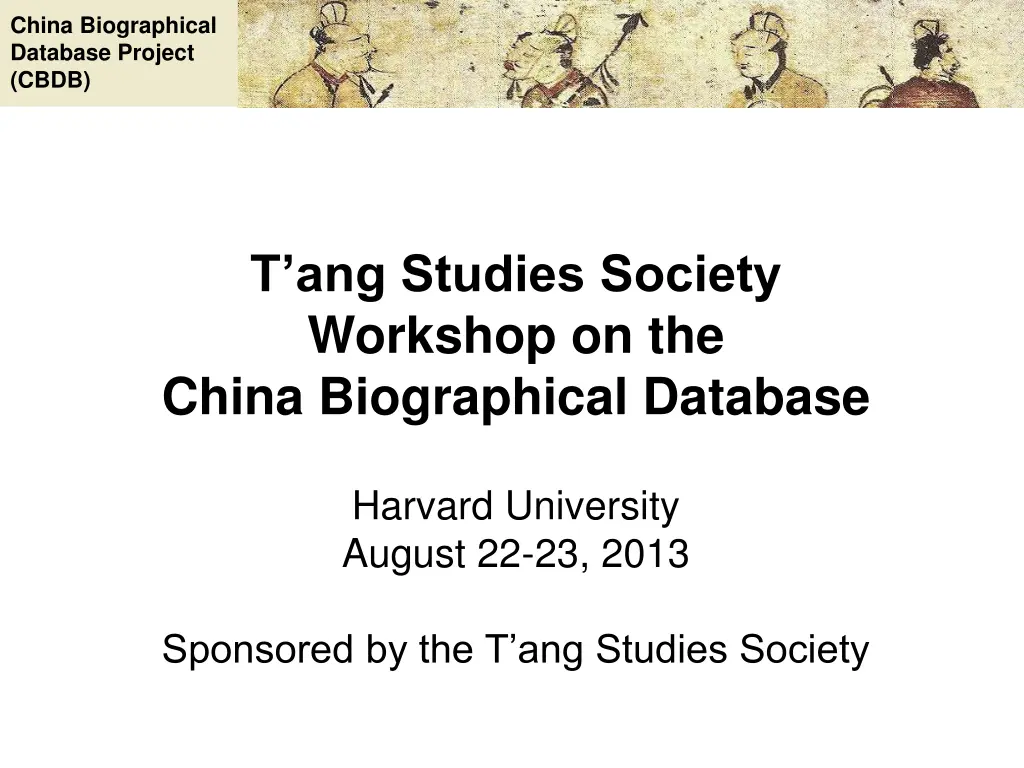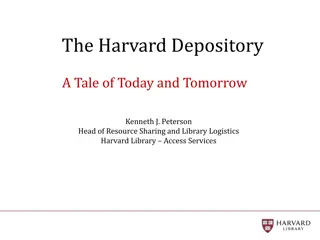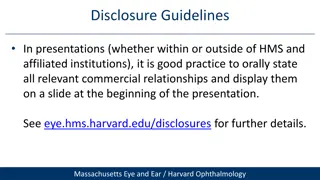
China Biographical Database Project: Integrating Data Efficiently
Explore the China Biographical Database Project (CBDB) and learn how to design research projects using relational database entities. Discover the workhorse table capturing People in Texts and how to integrate your data with CBDB. Get insights on the best practices to avoid repeating efforts and enhance your projects with code tables for easy look-up.
Download Presentation

Please find below an Image/Link to download the presentation.
The content on the website is provided AS IS for your information and personal use only. It may not be sold, licensed, or shared on other websites without obtaining consent from the author. If you encounter any issues during the download, it is possible that the publisher has removed the file from their server.
You are allowed to download the files provided on this website for personal or commercial use, subject to the condition that they are used lawfully. All files are the property of their respective owners.
The content on the website is provided AS IS for your information and personal use only. It may not be sold, licensed, or shared on other websites without obtaining consent from the author.
E N D
Presentation Transcript
China Biographical Database Project (CBDB) T ang Studies Society Workshop on the China Biographical Database Harvard University August 22-23, 2013 Sponsored by the T ang Studies Society
China Biographical Database Project (CBDB) Session Three: The Design of Research Projects using Relational Database Entities and CBDB Michael A. Fuller
China Biographical Database Project (CBDB) In your projects, you primarily will need to think about the design of the specific thing you want to link to CBDB and explore. For example, I have created a small sample database that can be used to record information on texts in a . Let s download and open it.
China Biographical Database Project (CBDB) The workhorse ( PeopleInTexts ) table captures People in Texts and has the following fields: Text (255) Text (255) Text (255) Text (255) Number (Integer) Text (255) Text (255) Memo Author PersonInText TextTitle TextType TextYear TextSource SourcePage CitationNotes
China Biographical Database Project (CBDB) And we have some initial data: PersonIn Text Person Role Subject Text Type Text Year Author TextTitle TextSource SourcePage CitationNotes 1.12.189- 93 1.11.183- 88 Subject 2.42.637- 38 1.11.178- 82 Recipient Subject 2.49.777- 78 1.19.296- 307 Subject Subject
China Biographical Database Project (CBDB) Having collected data, one needs to integrate it with CBDB data in order to avoid repeating effort. The best way to do it, at least initially, is to copy CBDB tables into your database. You will want: People Kinship Data Association Data Posting Data Text Data (?) ZZZ_BIOG_MAIN ZZZ_ENTRY_DATA ZZZ_BIOG_ADDR_DATA ZZZ_KIN_BIOG_ADDR ZZZ_NONKIN_BIOG_ADDR ZZZ_POSTED_TO_OFFICE_DATA ZZZ_POSTED_TO_ADDR_DATA ZZZ_TEXT_DATA Entry Data Place Data
China Biographical Database Project (CBDB) Also, add some code tables (for convenient look-up): Address Hierarchy Entry Codes Association Codes Place Association Codes Kinship Codes Dynasties Office Codes ZZZ_BELONGS_TO ENTRY_CODES ENTRY_TYPES ENTRY_CODE_TYPE_REL ASSOC_CODES ASSOC_TYPES ASSOC_CODE_TYPE_REL BIOG_ADDR_CODES KINSHIP_CODES DYNASTIES NIAN_HAO OFFICE_CODES OFFICE_TYPE_TREE OFFICE_CODE_TYPE_REL
China Biographical Database Project (CBDB) Now that you have added the CBDB tables, you ll need to link your table to them. First, you re going to need a list of all people in your table: Open the Query Builder Add your table Select the PersonInText field Run the query: note that you have duplicates. Go into SQL View add distinct after SELECT add as pname after PersonInText in the SELECT list Rerun the query Change the query to a Make Table (table = PNames1) Close and Save the query as My People1 Query Run
China Biographical Database Project (CBDB) Open the Query Builder again Add your table Select the Author field Go into SQL View add distinct after SELECT add as pname after Author in the SELECT list Change the query to a Make Table (table = PNames2) Close and Save the query as My People2 Query Run Copy all the records from PNames2 into PName1 Open the Query Builder again Add PName1 Select the pname field Go into SQL View add distinct after SELECT Close and Save the query as My People Query
China Biographical Database Project (CBDB) Open the Query Builder again Add ZZZ_BIOG_MAIN and My People Query Drag the pname field to c_name_chn in ZZZ_BIOG_MAIN Double-click on the link and select All records in My People Query Add PersonInText and c_personid, c_index_year Run the query Change the query to a Make Table (table = PeopleID) Close and save as PeopleID Query Run the query Open the new table PeopleID Delete the irrelevant records IF YOU NEED TO ADD PEOPLE TO ZZZ_BIOG_MAIN oh well, you have to add them: give them numbers starting with 300000 and let us know, so we can add them and report their CBDB system IDs to you.
China Biographical Database Project (CBDB) Step Two (if you wish): Normalize the data by breaking the PeopleInTexts table into five tables: 1. PeopleID (you just created) 2. TextID 3. RoleID 4. GenreID 5. PeopleTextData (swaps most of the text for codes)
China Biographical Database Project (CBDB) Once you have made the PeopleID table, you can see what data CBDB has on the people in your database. Please create this query:
China Biographical Database Project (CBDB) And this query:
China Biographical Database Project (CBDB) And this query:
China Biographical Database Project (CBDB) At this point, I ll get out of your way and let you start to develop a model for your project. If you have questions, I ll be circulating in the room.






















